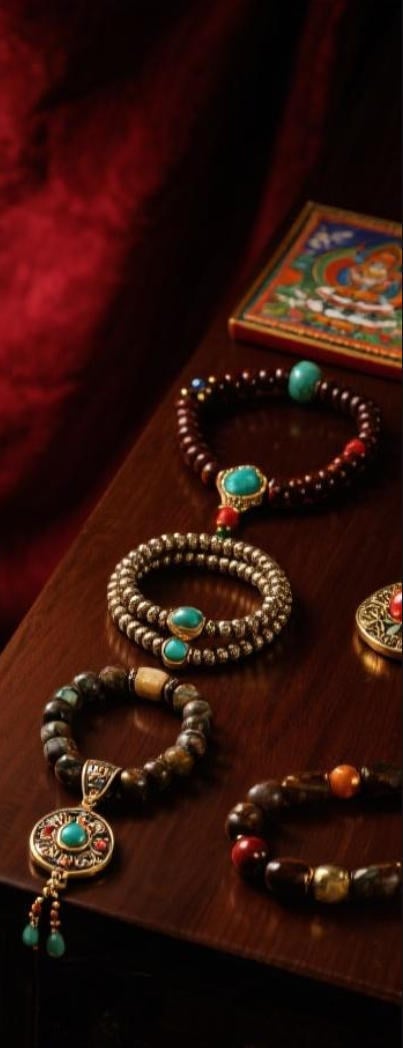
Within the meticulous design inside Tibetan faith systems are found two profound relics: the detailed thangka and symbolic bodhi ornament. Every single one, in individualized approach, enables transcendental awakening. The thangka, an intricate scroll, illustrates divine figures, symbolic diagrams, or Buddhist narratives, serving as a contemplative tool.
Yet, the bodhi bead, often crafted from fine gems, wooden material, pips, or bony material, is a tangible reminder of Buddha's illumination under the bodhi tree. Using the beads while meditating strengthens attentiveness.
- Jointly, the thangka and the bodhi bead express the fusion of creativity and faith. They offer a tangible link to the traditional insight of Tibetan Buddhism.
Tales Whispered by Camel Bone
Across the sands of time, old treasures whisper tales about a world long gone. These are not treasured objects from forgotten empires, but unpretentious camel bones incised with characters that unlock the stories of a bygone epoch. Each relic contains the echo sprung from a life lived, a journey completed, and a connection to the hallowed wisdom that surrounds us all.
- Those pieces
- Gifts
- Are
Delving into the Depths of Thangka Art: A Symbolic Journey
Tangkas are luminous paintings on canvas, meticulously crafted by Tibetan artists to depict sacred figures and scenes from Buddhist scriptures. Each detail within a thangka is laden with symbolism, forming a complex tapestry of visual narratives that guide the viewer on a mindful journey. The chromatics used in thangkas are not merely aesthetic choices but carry profound connotations, standing for different aspects of the Buddhist teachings. From the calm figures to the intricate designs, thangkas offer a view into the rich world of Tibetan Buddhism, inviting us to deliberate upon its enlightenment.
- Classic thangka art often depicts key Buddhist figures such as Buddha Shakyamuni, Bodhisattvas like Avalokiteshvara and Manjushri, and enlightened beings from various sects of Tibetan Buddhism.
- Across these representations lies a wealth of awareness that can be unlocked by those who explore the symbolic language of thangkas.
Siddhartha's Path to Enlightenment: Embodied in Beads and Bone
Upon the winding course to salvation, the Buddha used insignia imbued with profound value. Separate bead and bone held within them the core of his doctrine, presenting glimpses into the form of reality. Using their configuration, the Buddha conveyed profound realizations that surpass the realm of ordinary perception.
From chosen sacred beads, crafted from special materials, issued vibrations that aligned with the subtle powers within. The remains of a being, meticulously transformed into amulets, served as tangible reminders of the impermanence constitutional to all entities.
Thangkas: Windows into Himalayan Spirituality
Thangkas brilliant paintings on cloth serve as expressive representations of Himalayan spirituality. These intricate works of art, meticulously created with exquisite brushstrokes, depict a vast array upon Buddhist deities, mandalas, and scenes from historic scriptures. Each thangka is an instructive medium for meditation and contemplation, offering discernment into the intricate teachings of Buddhism.
- They are often used in ritual ceremonies for
- eliciting states of spiritual illumination.
- Thangkas are not merely decorative elements but rather pathways into the rich and alluring world of Himalayan spiritual traditions.
The Allure of Bodhi Beads: Exploring Mindfulness and Compassion
Each bead on a bodhi bead mala whispers tales of ancient wisdom, guiding us on a expedition through the tranquil waters of mindfulness. As we carry these intricately designed beads, our fingers trace the contours of separate one, anchoring our cognition in the present moment. The gentle feel of the beads against our palms serves as a tangible reminder to take in air, fostering a sense of composure.
- As each bead that passes between our fingers, we develop compassion, extending it first to ourselves and then outward to the world.
- Sacred teachings teaches us that mindfulness is a skill that requires patience and commitment.
Via the rhythmic repetition of mantra or simply the mindful registering of the beads, we emancipate from the relentless chatter of the mind.
The practice applying bodhi beads is a beautiful invitation to re-engage our connection with ourselves and the world around us.
The Power of Intention: Crafting a Camel Bone Bracelet for Spiritual Growth
Focus represents a compelling drive in our lives, shaping our experiences and guiding us towards our fated course. When we combine this intention with the ancestral experience of crafting a camel bone bracelet, we create a potent synergy that can boost our spiritual growth.Camel bone exudes mystical power, representing toughness. Its natural beauty and ancient magnetism serve as a constant reminder of the fundamental dynamic within each of us.As we carefully select each bone, infuse our intentions into the bracelet. With every knot or interlock, we interlace our hopes, dreams, and aspirations for spiritual evolution. This act of creation becomes a contemplative exercise, harmonizing us with our inner wisdom and guiding us on a pilgrimage of understanding.- Imbue each color element with specific spiritual meanings.
- Project your aims as you bind each component.
- Place it on an altar dedicated to your spiritual practice.
Unveiling the Significance of Camel Bones in Buddhist Traditions
In the rich tapestry throughout Buddhist tradition, artifacts often hold profound symbolic meaning. Throughout these varied objects, camel bone stands out as a unique and compelling element. Amid history, this material has been exploited in the crafting of various Buddhist objects, each imbued with specific significances.
- Appraised as a symbol of resilience and strength due to the camel's ability to thrive in harsh environments, camel bone often symbolizes spiritual fortitude.
- Besides, the color and texture regarding camel bone are believed at some to hold auspicious connotations, denoting purity and serenity.
Accordingly, camel bone has become a esteemed part of Buddhist folklore, serving as a tangible relation to the profound teachings of this ancient faith.
Thangka Canvases: Chronicles of the Sacred
Within the ethereal realm of Tibetan Buddhism, Thangka paintings emerge as sacred portals to enlightenment. These breathtaking works, meticulously crafted by skilled artists known as thangkapa, depict a myriad embracing vibrant deities, celestial beings, and mythical creatures. Each brushstroke saturates profound spiritual significance, narrating ancient tales and philosophical dogmas.
- Including a vast compendium of Buddhist iconography, Thangkas serve as both devotional objects and instructional tools. Pious practitioners gaze upon these paintings during rituals and meditations, seeking to pursue spiritual wisdom.
- Elegantly fashioned with intricate details embellished by diverse vibrant hues, Thangkas are considered windows into the divine. All painting acts as a symbolic representation of the Deity's teachings and the path to liberation.
Through their forceful imagery and symbolism, Thangka paintings offer a glimpse into the rich doctrinal traditions of Tibet. They are a testament to the enduring grace of Tibetan art and its profound ability to stimulate.
Embracing the Duality: Thangkas and the Cycle of Life and Death
Thangkas, radiant pictorial scrolls from Tibetan culture, embody a meaningful examination of life’s transience. Each intricate illustration depicts deities and beings engaged in the progressive venture of life and death, a panorama of birth, growth, impermanence, and reawakening. The artists skillfully interlace these concepts within the thangka's universe, highlighting the relation of all things. Through vivid illustrations, they invite us to ponder on our own life. The cycle recurs, a dance of coming and going, accentuating the preciousness of each moment. By embracing this duality, thangkas teach us to acknowledge the beauty in both life's joys and sorrows.Threads of Devotion: The Significance of Bracelets in Buddhist Practice
In the intricate tapestry of Buddhist practice, seemingly unassuming objects often hold profound meaning. Among these are bracelets, which serve as tangible emblems of devotion and commitment to the way of Buddha. Worn on the wrist, a bracelet works as a constant reminder of one's aspirations and aims. It can indicate the impermanence of life, inducing practitioners to remain rooted in the present moment. Some bracelets may hold sacred etchings, such as mantras or the names of Buddhas, which are acknowledged to elicit positive energy and preservation. Others may be made from matter with spiritual significance, like sandalwood or lotus seeds, improving the bracelet's yoga life force. Ultimately, the significance of a Buddhist bracelet stems far beyond its physical form. It becomes a powerful tool for mindfulness, a encouragement to live in harmony with the teachings of Buddha, and a expression of one's unwavering commitment.